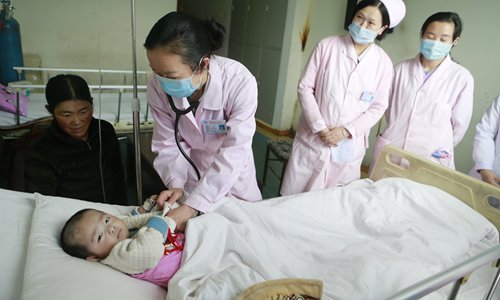
Doctors check on a child suffering from heart disease. (Photo/GT)
Provincial cooperation
Starting a couple years ago, hospitals in Tibet launched joint programs with out-of-province hospitals and doctors, both those organized by the government and grass-roots exchanges, in order to help improve the situation in the region. Starting in 2012, the central government provided funds for children in Tibet to be treated for free with outside help.
Cooperation between Tibet People's Hospital and West China Women and Children's Hospital started in 2012. As of today 217 children have been treated as part of this partnership.
Help came in the form of outside hospitals sending doctors and nurses to Tibet to conduct health checkups and perform surgeries, as well as bringing patients to Sichuan for surgery. Besides, there were exchanges of up-to-date techniques and research.
Hua's team has been coming to Tibet every year to help train local doctors and perform surgeries. This April was the first time their Tibetan partner hospital asked Hua's team to help with health checkups.
The operations they give children are usually simple, Shan said.
"It's a micro operation and once performed, the child can walk after 24 hours and can leave hospital care within three or four days," she said. "And it will cure the disease once and for all. In the future, they will develop like normal children."
Yet the partnership process had been difficult. Many outside doctors can't get used to the environment in Tibet and many suffer altitude sickness when they first arrive. But despite these difficulties, they still perform checkups and operations under these conditions.
At the same time, it isn't easy on the children who are asked to leave Tibet for treatment either. But the results are quite obvious.
Tsering Dolkar, a young boy from a village in Shannan prefecture, was cured in 2013 through a joint effort between the two hospitals.
Yungchen Drolma, his grandmother, said excitedly that "the hospital has given my grandson a second life." When the child was sick, the family had no way of helping him. They didn't have much money and couldn't afford to send the child to the hospital. Now their child was treated for free and he has fully recovered, indeed he could walk within two hours of the operation.
Future advances
Besides in Sichuan, Tibetan hospitals have been holding a number of exchanges and cooperative trips with other parts of China in recent years, including Beijing. Media reports show staff and volunteers from multiple hospitals have gone to Tibet to perform health checkups and bring back patients to perform surgeries.
Every year, thousands of children receive help from hospitals outside Tibet. At the beginning of 2012, the Communist Party of China's Tibet committee announced a plan to provide free medical assistance to all children with congenital heart disease in the region within two years.
Hospitals in a variety of cities including Beijing and Shanghai have joined these efforts.
According to a May 2016 media report, a team of experts from a Shanghai specialist cardiovascular hospital were sent to the Ngari prefecture of Tibet for eight days to do health checkups and perform surgeries. Ngari has an average altitude of 4,500 meters and a particularly high heart disease rate. According to data from the Ngari Red Cross Society, about 40 children develop heart diseases every year in Ngari.
But Shan says she doesn't want to rely solely on friendly outside forces, because it comes down to self-sufficiency and improving the local medical level, she said.
Hua feels the same way. He said from the start, he wanted doctors in Tibet to be able to perform surgeries and have cooperation between departments on curing heart diseases at the same level as in more advanced provinces, because doctors from other hospitals can only do a limited amount and devote limited time traveling to Tibet.
While he was in Tibet, he started holding lectures and discussions for the doctors there. Local medical staff also observe the operations and learn first hand about new technologies and methods of treatment.
Furthermore, Tibet is included in a cooperation net that includes many cities in the country's west.
Starting last year, hospitals in 10 provincial-level regions, including Tibet, Sichuan, Guizhou and Yunnan agreed to set up a cooperation network to better improve exchanges between regions and communications on technical advancements.
"If we are to pay attention to children in the entire western region, Tibet shouldn't be quiet about it," Shan said. "Instead, we should also contribute with our own powers."


















































